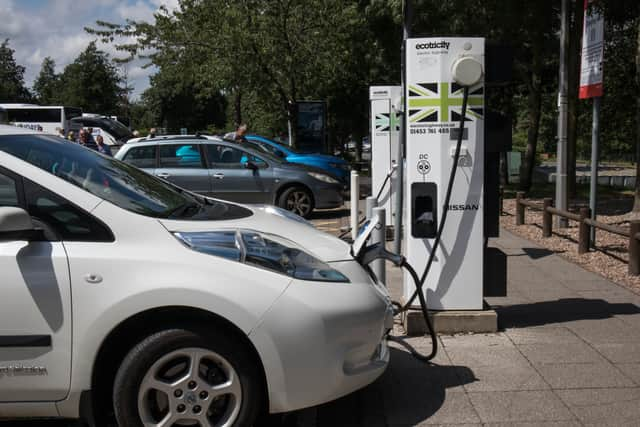Electric car charging: government set to miss 2023 motorway charger target, says RAC
and live on Freeview channel 276
The government is ‘unlikely’ to achieve its target for the roll-out of electric car chargers on England’s motorways, according to new research.
The Department for Transport wants every service station in the country to have a minimum of six rapid or ultra-rapid chargers by the end of 2023 as it aims to boost infrastructure on key routes. But figures obtained by the RAC suggest that only a quarter of locations currently meet that target.
Advertisement
Hide AdAdvertisement
Hide AdThe RAC said that based on current roll-out rates it was doubtful that the target would be reached by the end of the year and warned that a lack of accessible charging could slow the adoption of EVs.
Using data from mapping service Zap-Map, the motoring group identified 27 out of 119 motorway service areas (23%) where there were at least six rapid chargers. It said that in total there were around 400 high-powered devices - offering 50kW or more - meaning an average of 3.4 chargers at each station.
However, while some locations had up to 12 charging devices, it found six sites without a single rapid charger. These were Leicester Forest on both sides of the M1, Tebay South on the M6, Carlisle Northbound on the M1, Strensham Southbound on the M5 and Barton Park on the A1(M).
While the government is not responsible for the installation of EV chargers, its EV infrastructure strategy published last year states: “We will ensure that every motorway service area has at least six rapid chargers by the end of 2023, with some having more than 12.”
Advertisement
Hide AdAdvertisement
Hide AdThere are currently only six services in England which have more than 12 high-powered devices. These are Exeter on the M5, Rugby on the M6, Reading East and West on the M4, Thurrock on the M25 and Wetherby on the A1(M). Earlier this year, National Highways began installing huge battery arrays stored in shipping containers as a short-term solution to the need for more chargers along motorways.
The latest figures from Zap-Map show that the UK has 42,566 charging devices of which a fifth (19% or 7,928) are rapid or ultra-rapid. However, just 5% of all these high-powered chargers are at motorways services.


RAC EV spokesperson Simon Williams said: “Our findings show there is much work to be done before the end of the year if the government’s target of having six high-powered chargers at every motorway service area is to be met.
“Installing these types of units is not straightforward as connecting to the electricity grid is expensive and time-consuming, but clearly more needs to be done to make this process simpler than it is currently. While we understand the government is taking steps to expedite matters, the importance of ensuring sufficient high-powered charging is readily available up and down our motorway network can’t be emphasised enough.
Advertisement
Hide AdAdvertisement
Hide Ad“As a lack of charging facilities is rapidly becoming one of the most widely quoted reasons for drivers not going electric, all parties involved in making installations happen must work together to overcome this obstacle."
Quentin Willson, founder of the EV campaign FairCharge, added: “When you look at how quickly Tesla put their Superchargers into the motorway service network, you’re forced to wonder why the government is working at such glacial speed to do the same. We simply must pick up the pace building a long-range, high-powered charging infrastructure to offer confidence to electric car drivers, the EV market and global investors.”
Data from Zap-Map shows that charger installations are accelerating. More than 6,400 new units have been installed so far in 2023, with an average of 1625 new chargers being installed each month compared to 914 per month across the same period in 2022 and 1115 per month across the whole of 2022.
Sue Davies, head of consumer protection policy at consume title Which?, said: "It's disappointing that the government currently looks set to miss this target, especially as Which? research found that one of the main barriers preventing drivers from switching to electric vehicles was concerns about a public charging infrastructure that is falling short.
Advertisement
Hide AdAdvertisement
Hide Ad“Charging should be easy, reliable and seamless to support people making the move to an electric car. The government must quickly improve the consumer experience of using public charging networks so that drivers feel confident making the switch to an electric vehicle when they are ready."
A DfT spokesperson said: “While 97% of motorways service areas already have charging available, industry has plans to install many 100s more chargepoints in the coming months.
"We‘ve put more than £2bn into accelerating the transition to electric vehicles, and our £950m Rapid Charging Fund will further boost charging to support long distance journeys, including at motorway services."
Comment Guidelines
National World encourages reader discussion on our stories. User feedback, insights and back-and-forth exchanges add a rich layer of context to reporting. Please review our Community Guidelines before commenting.
